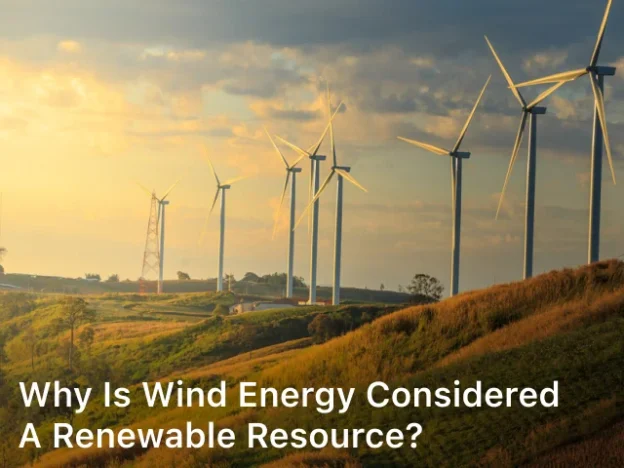greentechinnovate.com. Why is Wind Energy Considered a Renewable Resource? – Discover the incredible benefits of wind energy and learn why it is hailed as a renewable resource. This in-depth article explores the sustainable power of wind, its environmental advantages, and answers frequently asked questions. In an era where sustainable solutions are paramount, wind energy stands out as a shining example of renewable resources. Harnessing the power of the wind has been a practice as old as time, but in recent years, it has evolved into a sophisticated, eco-friendly means of generating electricity. In this article, we’ll delve into the remarkable aspects of wind energy and explore why it is considered a renewable resource. What is Wind Energy Wind energy is a renewable and sustainable form of electricity generated by harnessing the kinetic energy of the wind and converting it into usable power. It is a clean and environmentally friendly source of energy that has gained increasing prominence in recent years as a key component of the transition to more sustainable and eco-conscious power generation methods. Here’s how wind energy works: Wind Turbines: The primary technology used to capture wind energy is the wind turbine. These turbines consist of several key components, including a tall tower, multiple rotor blades, and an electrical generator. Wind Capture: As the wind blows, it imparts kinetic energy to the rotating blades of the wind turbine. The blades are designed to capture the maximum amount of wind energy and start to turn when the wind speed reaches a certain threshold. Electricity Generation: The rotation of the blades drives the generator, which converts the mechanical energy into electrical energy. This electricity can then be used to power homes, businesses, or other electrical devices. Key features and aspects of wind energy include: Renewable Nature: Wind is an abundant and replenishable resource, making wind energy a renewable source. As long as the wind blows, there will be a continuous supply of energy. Environmental Benefits: Wind energy is considered environmentally friendly because it does not produce harmful emissions or contribute to air pollution. It reduces the carbon footprint and helps combat climate change. Energy Independence: Wind energy reduces dependence on fossil fuels, offering greater energy security and reducing exposure to fluctuating fuel prices. Location Variability: The effectiveness of wind energy is location-dependent. It is most suitable in regions with consistent and strong winds, such as coastal areas, plains, and mountain ridges. Scaling Options: Wind energy can be harnessed at various scales, from small residential turbines to large, utility-scale wind farms that can power entire communities or regions. Intermittency: One of the challenges of wind energy is its intermittency. Wind speed can vary, and there are periods when the wind does not blow, necessitating backup power sources or energy storage solutions. Technological Advancements: Ongoing technological advancements have improved the efficiency and cost-effectiveness of wind turbines. Innovations in design, materials, and maintenance practices have made wind energy increasingly competitive with traditional energy sources. Wind energy is a key component of the global effort to transition to cleaner and more sustainable energy sources, contributing to a reduced environmental impact and a more secure energy future. It plays a crucial role in reducing greenhouse gas emissions and mitigating the effects of climate change, making it an essential part of the renewable energy mix. Why is Wind Energy Considered a Renewable Resource Wind energy is considered a renewable resource for several compelling reasons, and understanding these factors is crucial to appreciating its significance in the realm of sustainable power generation. Here are the key reasons why wind energy is hailed as a renewable resource: Inexhaustible Wind Supply Wind is an abundant and naturally occurring energy source that is perpetually replenished by the Earth’s atmospheric conditions. Unlike finite fossil fuels, which are gradually depleting, the wind supply is virtually inexhaustible. As long as the sun shines and the Earth rotates, wind will continue to blow, making it an inherently renewable energy source. Low Environmental Impact Wind energy production involves the use of wind turbines, which generate electricity without emitting greenhouse gases or other harmful pollutants. This eco-friendly aspect of wind energy is in stark contrast to fossil fuel-based power generation, which contributes significantly to global warming and air pollution. By harnessing the wind, we can reduce our reliance on fossil fuels and minimize the environmental impact. Sustainability and Consistency Wind patterns can be highly predictable, especially in regions with consistent wind resources. This predictability allows for effective energy planning and grid integration. Even though wind energy production may vary on a daily or seasonal basis, it remains a sustainable and reliable source of power in the long term. Reduced Carbon Footprint: Utilizing wind energy significantly reduces the carbon footprint associated with electricity generation. The absence of carbon dioxide (CO2) emissions during wind energy production helps mitigate the effects of climate change and contributes to cleaner air and a healthier environment. Energy Security Wind energy enhances energy security by diversifying the energy mix. Relying on a single source of energy, such as fossil fuels, can make a region vulnerable to supply disruptions or price fluctuations. Wind energy reduces this dependence, promoting energy security and stability. Economic Benefits The renewable energy sector, including wind energy, fosters economic growth by creating jobs in manufacturing, installation, maintenance, and research and development. Wind farms also provide revenue to landowners through land lease agreements, stimulating local economies and benefiting communities. Energy Independence Reducing reliance on imported fossil fuels through wind energy adoption enhances a nation’s energy independence and reduces its exposure to global energy market volatility and geopolitical conflicts. Global Potential Wind energy can be harnessed on a global scale. Favorable wind conditions are found on every continent, making it a versatile and accessible energy source for countries around the world. Wind energy is considered a renewable resource due to its abundance, low environmental impact, sustainability, and the positive effects it has on our environment and energy security. As the world continues to grapple with the challenges of climate change and





